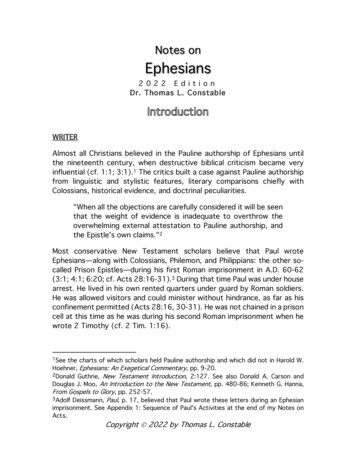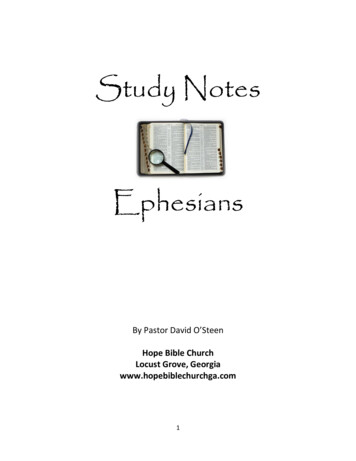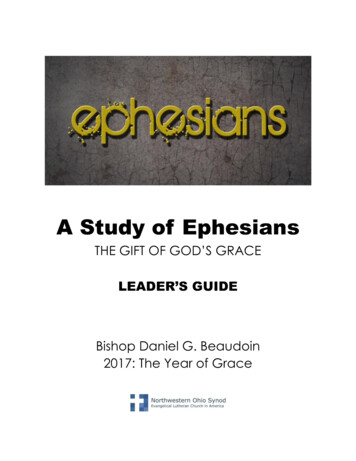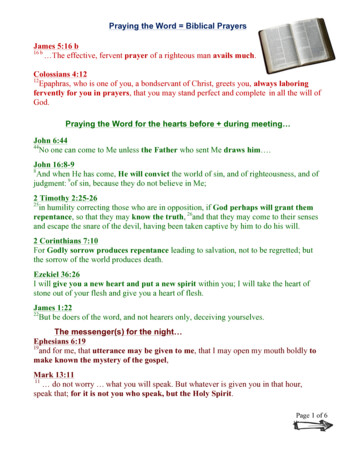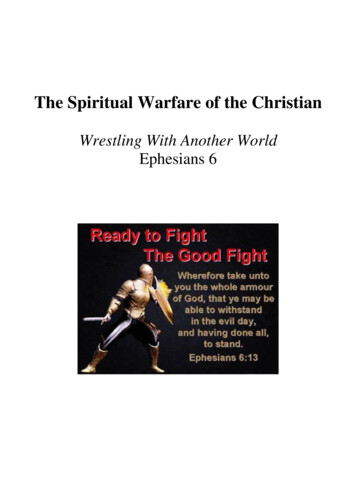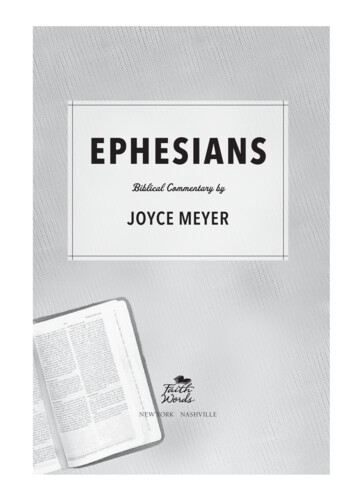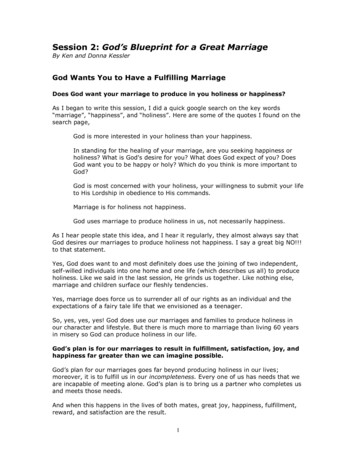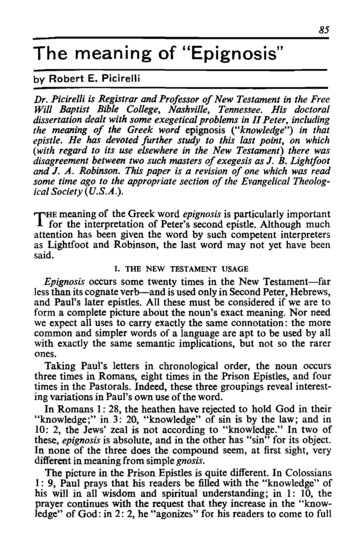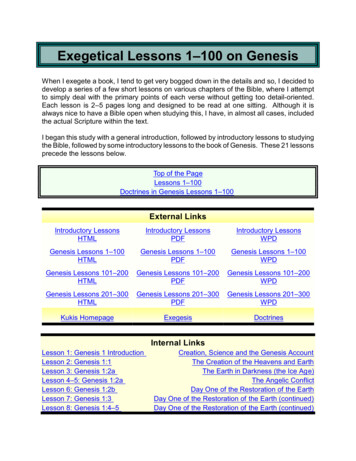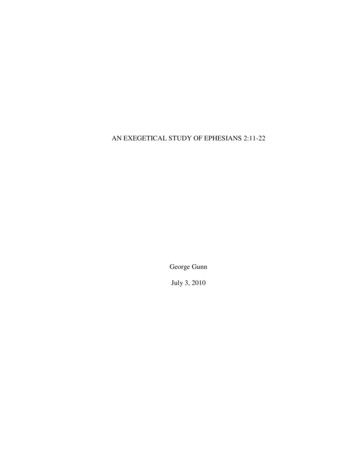
Transcription
AN EXEGETICAL STUDY OF EPHESIANS 2:11-22George GunnJuly 3, 2010
Contents1. Verify Text & Translation – Section #1. Preliminary Passage Overview22. Understand Background & Context - Section #2. Background/Context Summary73. Identify Structure - Section #3. Outline/Structural Summary104. Identify Grammatical Keys – Section #4. Grammatical Summary165. Identify Lexical Keys - Section #5. Lexical Summary256. Identify Biblical Context - Section #6. Biblical Context Summary397. Identify Theological Context - Section #7. Theological Context Summary418. Secondary Verification - Section #8. Correlation Summary469. Exposition - Section #9. Analysis & Impact61Bibliography1131
21. Verify Text & Translation – Section #1. Preliminary Passage Overviewa. Study the passage in four different translations and identify any key differences orissues in the translations. Note variants. Translations selected for comparison: NASB95, ESV, NKJV, HCSBb. Write a passage overview identifying the following elements:i. Identify variants in the text2:11NASB “so-called circumcision”ESV “what is called the circumcision”NKJV “what is called the Circumcision”HCSB “those called ‘the circumcised’”UBS4 τῆς λεγομένης περιτομῆς2:12NASB “separate from Christ”ESV “separated from Christ”NKJV “without Christ”HCSB “without the Messiah”UBS4 χωρὶς Χριστοῦ2:13NASB “Christ”ESV “Christ”
3NKJV “Christ”HCSB “Messiah”UBS4 Χριστοῦ2:14NASB “the barrier of the dividing wall”ESV “the dividing wall”NKJV “the middle wall of separation”HCSB “the dividing wall”UBS4 τὸ μεσότοιχον τοῦ φραγμοῦ2:15NASB “thus establishing peace”ESV “so making peace”NKJV “thus making peace”HCSB “resulting in peace”UBS4 ποιῶν εἰρήνην2:16NASB “reconcile them both”ESV “reconcile us both”NKJV “reconcile them both”HCSB “reconcile both”
4UBS4 ἀποκαταλλάξῃ τοὺς ἀμφοτέρους2:18NASB “in one Spirit”ESV “in one Spirit”NKJV “by one Spirit”HCSB “by one Spirit”UBS4 ἐν ἑνὶ πνεύματι2:19NASB “strangers and aliens”ESV “strangers and aliens”NKJV “strangers and foreigners”HCSB “foreigners and strangers”UBS4 ξένοι καὶ πάροικοι2:21NASB “being fitted together”ESV “being joined together”NKJV “being fitted together”HCSB “being fitted together”UBS4 συναρμολογουμένη
5ii. Briefly summarize the passageBoth Gentiles and Jews were once spiritually dead, due to sins, butGod has united Jews and Gentiles together in Christ, giving them spirituallife by His grace so that they can now produce good works to the glory ofGod.iii. Summarize your current understanding of the theological impact of thepassage2:12 In the previous dispensation involvement in the covenants ofpromise were tied to the commonwealth of Israel.2:13 In the present dispensation Gentiles can be brought near to God apartfrom citizenship in national Israel by being “in Christ Jesus.” The “blood of Christ” is the means by which Gentiles are included inChrist.2:14-16 The Law of Moses came to an end at the crucifixion of Christ. The Law of Moses had constituted a barrier between Jews andGentiles that has now been removed.
6 Being “in Christ” makes one part of a “new man.” Being “in Christ” established peace between Jew and Gentile.2:17 The preaching of the Gospel today by human speakers is theequivalent of Christ Himself personally speaking.2:18 Being “in Christ” gives the believer access to the Father through theagency of the Holy Spirit.2:20-21 The foundation of the church is the “apostles and prophets;” Christ isthe cornerstone.iv. Identify doctrinal presuppositions you have in approaching the passage1. I believe firmly in Free Grace Salvation, not “Lordship Salvation.”2. I am a committed Dispensationalist.3. I am Calvinistic
72. Understand Background & Context - Section #2. Background/Context Summarya. Identify, defend, and explain the significance of literary form/genre (prophecy,historical narrative, epistle, poetic).This is epistolary literature. The author is laying out a reasoned presentationof his doctrine.b. Research key questions regarding the background of the book (authorship,composition, purpose, etc.).Though 1:1 clearly names the apostle Paul as the author (also 3:1), liberalscholarship has often questioned Pauline authorship of this epistle. One of thechief reasons has to do with the use of certain words and phrases that are taken tobe non-Pauline. Of course this is somewhat circular reasoning! Pauline authorshipof this epistle was universally accepted in the early church and not reallyquestioned until modern times.Recipients: The words “in Ephesus” are missing from many of the oldest andbest mss. in 1:1. For this reason we cannot be certain about who the recipientswere. Some scholars feel that this was an encyclical letter intended for thechurches of the Roman Province of Asia, of which Ephesus was the chief city.This would explain the fact that Paul does not mention any individuals in thereceiving church by name as he does in most of his other letters. Others think thismay possibly be the lost letter to Laodicea referred to in Col. 4:16.Apparently Tychicus delivered the letter, Eph. 6:21-22. Tychicus alsodelivered Paul’s letter to the Colossians, Col. 4:7-9.
8Paul had wanted to visit Ephesus early on his second missionary journey, butwas forbidden by the Holy Spirit, Ac 16:6-8.The first Ephesian converts to Christ came near the end of Paul’s secondmissionary journey when Paul stopped briefly at Ephesus, Ac 18:19-21.In the early part of Paul’s third missionary journey, Apollos, Aquilla, andPriscilla ministered in Ephesus, Ac 18:24-28.Later on in the third missionary journey, Paul came to Ephesus and spent wellover 2 years there, Ac 19:1-10.When a riot erupted, Paul was forced to leave Ephesus, Ac 19:11 – 20:1.Date of writing: Paul was a prisoner at the time of writing (3:4; 4:1; 6:20).This probably narrows the possibilities either to his Caesarean imprisonment (Ac23:23ff.) or his first Roman imprisonment (Ac 28:16ff.). There is also apossibility of an imprisonment in Ephesus itself (1Co 15:32; 2Co 1:8-10).Purpose: No specific problem is mentioned in the epistle; however, either thenoun or verb “love” occurs 19 times in Ephesians, which may point to a need therecipients had to be encouraged to demonstrate love in their lives. Compare thiswith Christ’s warning to the church in Ephesus, “You have left your first love”(Rev 2:4), and the frequent mention of love in 1 John, also likely written to thechurch in Ephesus.c. Summarize background and context highlighting the following elements:historical, social, geographical, authorship, date, literary form.For most of these points, see preceding section.
9As to literary form, the book appears to be divided into two main sections,with 4:1 constituting the pivotal point. The conjunction “therefore” (οὖν) joinsthese two halves together, the terms “walk” and “calling/called” eachcharacterizing the halves. Ch. 1-3 constitute a description of the believer’s callingin Christ. Ch 4-6 constitute an exhortation to walk in love. An analysis of the verbmoods in these two halves of the epistle corresponds with this description: inchapters 1-3, only 0.8% of all verbs are in the imperative (ch. 1, 0%; ch. 2 2%; ch.3, 0%), while 38.2% are indicative; whereas in chapters 4-6, 19.8% of all verbsare in the imperative (ch. 4, 15.3%; ch. 5, 23.9%; ch. 6, 20.4%).d. Identify how these findings are significant to interpretation of the passage.This passage is roughly in the center of the doctrinal section of Ephesians. It ispart of Paul’s argument in laying out the doctrine of the believer’s calling inChrist. As such it will lay a part of the foundation for the practical exhortations inpart 2 of the epistle.If indeed the purpose of the epistle has to do with the need to exhort thebelievers in Ephesus to display love, it is interesting that the immediate context ofour passage has such abundant description of God’s attributes of mercy, love,grace and kindness (2:4-8).
103. Identify Structure - Section #3. Outline/Structural Summarya. Outline the book, identifying major and minor divisionsIntroduction, 1:1-2I.Doctrinal, 1:3-3:21a. The work of the Triune God in Redemption, 1:4-14b. Paul’s Prayer, 1:15-23c. Jew and Gentile joined together in Christ, 2:1-22i. Both Jew and Gentile spiritually dead by nature, 2:1-10ii. Distant Gentiles brought near to the covenant Jews through thedeath of Christ, 2:11-22d. Paul’s Prayer 3:1-21 (Introduced by Τούτου χάριν)i. Digression, 3:2-13“The administration of the grace of God”ii. Resumption of Prayer, 3:14-21 (Note the repetition of Τούτουχάριν)II.Hortatory, 4:1-6:20 (Note the transitional marker οὖν)a. Unity and Growth of the Body, 4:1-16b.Put off the old man & put on the new man, 4:17-6:9 (Note theintroduction of a new topic by Τοῦτο οὖν λέγω καὶ μαρτύρομαι ἐνκυρίῳ)c. The Struggle Against Spiritual Wickedness, 6:10-20 (Note thetransitional Τοῦ λοιποῦ)Conclusion, 6:21-24
11b. Identify structural keys/developments (development of narrative, development ofargument, chiasm, 2829Διὸ μνημονεύετεὅτι ποτὲ ὑμεῖς 12 ὅτι ἦτε τῷ καιρῷ ἐκείνῳ χωρὶς Χριστοῦ, [ID 1]τὰ ἔθνη ἐν σαρκί, app 2 οἱ λεγόμενοι ἀκροβυστία ὑπὸ τῆς λεγομένης περιτομῆς app 2 ἐν σαρκὶ spa 4, περιτομ. χειροποιήτου, dsc 4, περιτομ. ἀπηλλοτριωμένοι τῆς πολιτείας τοῦ Ἰσραὴλ app 2 καὶ ξένοι τῶν διαθηκῶν τῆς ἐπαγγελίας, app 2 ἐλπίδα μὴ ἔχοντες app 2 καὶ ἄθεοι ἐν τῷ κόσμῳ. app 2 13αβγνυνὶ δὲ ὑμεῖς ἐγενήθητε ἐγγὺς . adv 1 α ἐν Χριστῷ Ἰησοῦ sph 11 γ. ἐν τῷ αἵματι τοῦ Χριστοῦ. mns 11 β οἵ ποτε ὄντες μακρὰν app 11 14Αὐτὸς γάρ ἐστιν ἡ εἰρήνη ἡμῶν,[cau 11]ὁ ποιήσας τὰ ἀμφότερα ἓν app 15 καὶ τὸ μεσότοιχον τοῦ φραγμοῦ λύσας, ἐν τῇ σαρκὶ αὐτοῦ, app 15 τὴν ἔχθραν app 17 15τὸν νόμον τῶν ἐντολῶν ἐν δόγμασιν καταργήσας,[mns 17]ἵνα τοὺς δύο κτίσῃ ἐν αὐτῷ εἰς ἕνα καινὸν ἄνθρωπον[pur1 15]ποιῶν εἰρήνην[res 20]16καὶ ἀποκαταλλάξῃ τοὺς ἀμφοτέρους[pur2 15]ἐν ἑνὶ σώματι[sph1 22]τῷ θεῷ[goal 22]διὰ τοῦ σταυροῦ,[mns 22]ἀποκτείνας τὴν ἔχθραν ἐν αὐτῷ.[cau 15]17καὶ εὐηγγελίσατο εἰρήνην ὑμῖν τοῖς μακρὰν[con 15] ἐλθὼν[TC2 27]καὶ [sc. εὐηγγελίσατο] εἰρήνην τοῖς ἐγγύς·[con 27]111This phrase expresses sphere only if σῶμα is referring to the church, the “body” of Christ; however, ifσῶμα refers to Christ’s physical body, then it would express means, and this would be a reference to His crucifixion.2Since both the participle and the main verb are in the aorist, the participle can express contemporaneoustime. The “coming” here is probably a reference to the coming of Christ in the Holy Spirit on Pentecost to preachthe gospel through the apostles.
121830ὅτι ἔχομεν τὴν προσαγωγὴν οἱ ἀμφότεροι31 διʼ αὐτοῦ32ἐν ἑνὶ πνεύματι33πρὸς τὸν πατέρα.1934 ἄρα οὖν οὐκέτι ἐστὲ ξένοι καὶ πάροικοι35 ἀλλὰ ἐστὲ συμπολῖται τῶν ἁγίων καὶ οἰκεῖοι τοῦ � ἐπὶ τῷ θεμελίῳ37τῶν ἀποστόλων38καὶ προφητῶν,39ὄντος ἀκρογωνιαίου αὐτοῦ Χριστοῦ Ἰησοῦ,2140ἐν ᾧ πᾶσα οἰκοδομὴ αὔξει41εἰς ναὸν ἅγιον42 συναρμολογουμένη43ἐν κυρίῳ,2244ἐν ᾧ καὶ ὑμεῖς συνοικοδομεῖσθε45εἰς κατοικητήριον τοῦ θεοῦ46ἐν πνεύματι.Explanation of tags from preceding diagram:ACAttendant uCausalconConnectivedscDescriptiongoal GoalIDIndirect DiscourseinfInferentialman Mannermns MeanspurPurposeRCRelative ClauseresResultspaSpatialsphSphereSubG Subjective GenitiveTCTime Contemporaneous[cau 29] agn 30 agn 30 goal 30 [inf 1-33][adv 34][cau/mns? 35][SubG 36][SubG 36][AC 36][RC 39, Ι.Χρ.] goal 40 [man/mns 40] sph 40 [RC 39, Ι.Χρ.] goal 44 mns 44
13The passage divides into 3 sections, the main divisions occurring at verses 13and 19. The first main division, at verse 13, separates the passage into past andpresent. Verse 11 opens with διὸ μνημονεύετε (“therefore remember”), which looksto the past. The shift to the present occurs in verse 13 with the words νυνὶ δέ (“butnow”) which brings us into the present. The final section is a conclusion based on thepreceding two sections and is introduced by the inferential phrase ἄρα οὖν(“therefore”). Thus a first level outline of the passage would be as follows:I.Past, 11-12II.Present, 13-18III.Conclusion, 19-22The first section (Past) asserts via an indirect discourse clause, “you werewithout Christ.” The subject, “you,” refers to the recipients of the letter, and has inview the majority Gentile makeup of the church(es). The identity of these Gentiles isfurther delineated by a series of appositional phrases; they were: “Gentiles in flesh,”“called ‘uncircumcision,’” “alienated from citizenship in Israel,” “strangers from thecovenants of promise,” “those who have no hope,” and “godless ones in the world.”Thus, the first main division may be expanded as follows:I.Past condition of the Gentiles, 11-12a. Lacking the physical sign of membership in God’s covenant nationb. Despised by the covenant peoplec. Lacking legal status in God’s covenant nationd. Having no relationship to God’s covenant promisese. Hopeless
14f. GodlessThe second section (Present) includes both second person plural referencesand first person plural references (v. 14 “our peace,” v.18 “we have”). The secondperson references continue viewing the majority Gentile makeup of the church(es);whereas, the first person references bring in the minority Jewish makeup, and includeeven the author of the letter. What begins as a first person plural reference thencontinues as third person plural using ἀμφότεροι “both,” or οἱ δύο “the two.” Thus wesee verse 13 describing the “bringing near” of the Gentiles, and verses 14-18describing the joint participation of both Gentile and Jew in the Body of Christ:II.Present: Both Jew and Gentile Participate Equally in the Body of Christ,13-18a. Bringing the Gentiles Near, 13b. Joint Participation of Both Jews and Gentiles, 14-18The conclusion returns to the second person plural and drops the references toἀμφότεροι and δύο; thus, the application is primarily to the majority Gentilepopulation of the church(es). However, the interesting compounds συναρμολογέω (v.21) and συνοικοδομέω (v. 22) bring in references to the Jews as participating with theGentiles in this application. This concluding section brings in the two metaphors ofcitizenship in a commonwealth, and of a building and a temple. This last metaphorsees both Jewish and Gentile believers as the building blocks, the apostles andprophets as the foundation, and Christ as the Cornerstone of the building.
15III.Conclusion: Gentiles are included with Jews as the people of God, 19-22a. Pictured as Citizenship in a Commonwealth, 19b. Pictured as a Building and Temple,20-22i. The Foundation, 20aii. The Cornerstone, 20biii. The Building Stones, 21-22c. Identify the importance of the structure in the interpretation of the passageThe structure of the passage indicates that it is addressed primarily to Gentilebelievers in Christ. This suggests the likelihood of a latent anti-Semitism among theseGentile believers that Paul was attempting to correct. These Gentile believers were tounderstand that the Jews, though they had not received Jesus as their Messiah, werestill accounted as the covenant people of God, and thus were closer to God than theunbelieving Gentiles. As for those Jews who have believed in Jesus, believingGentiles should consider themselves to be privileged to be related to them on an equalstatus, now that they are all “in Christ.”
164. Identify Grammatical Keys – Section #4. Grammatical Summary1. Identify historical/cultural references, figurative language, rhetorical devices, quotations,etc.a. Historical/Cultural Referencesi. Jew/Gentile relationship in first century Asia Minor, v.11Ac 21:28 illustrates the animosity between Jews and Gentiles.ii. Citizenship, vv. 12, 19iii. Crucifixion, v. 16iv. Building practices/materials, vv. 20-22v. Temples, v.21b. Figurative Languagei. v.14 “He is our peace” – Here is an instance of metonymy in which theeffect is put for the cause. In this case, the noun “peace” is the result ofHis action of bringing about peace. Expressed literally, we wouldunderstand “He effected our peace.”ii. v.14 “having destroyed the middle dividing wall” – Here we see metaphor.The literal “middle dividing wall” is likely a reference to the interior wallof the Jerusalem temple complex that separated the court of the Gentilesfrom the remainder of the court. Gentiles were not permitted beyond thisdividing wall, on pain of death. In the figure, Christ is said to havedestroyed the dividing wall by means of (ἐν) His flesh (crucifixion). Whatdoes the wall represent? This is answered in twin appositional phrases: (1)“the enmity” (ἔχθρα); and (2) “the law of the commandments in
17ordinances” (τὸν νόμον τῶν ἐντολῶν ἐν δόγμασιν). This secondappositional phrase appears to reference quite obviously the Mosaic Law.The point of the metaphor is that in His death, Christ destroyed the MosaicLaw as an institution that gave favored status to the Jews.iii. v.15 “one new man” (εἷς ἄνθρωπος κενός) – Elsewhere the uniting ofvarious members in Christ is referred to by the metaphor of the “body” ofChrist. Here the metaphor is slightly different; it is a “new man.” Thismight be synecdoche whereby the whole “man” stands for the part,namely the “body.” But one wonders why Paul used the adjective “new.”In Eph. 4:22, 24 there is a contrast between the “old man” and the “newman,” but there, the reference is to individual believers; whereas, here in2:15, the reference is corporately to the church. In keeping with Paul’stheology as expressed in Rom. 5:12ff., perhaps the “old man”(unexpressed, but nevertheless implied here) would refer to “Adam” andthe “new man” to Christ, as spheres in which men live, either incondemnation or righteousness.iv. v.19 “you are no longer foreigners and aliens” – The point of thismetaphor is that, before they were in Christ, the Gentiles were notincluded in the blessings that attach to citizenship in the nation of Israel,but now, despite their Gentile status, they were recipients of God’sblessing. This figure might be understood in one of two ways: (1) Inreplacement theology, this would be taken to mean that faith in Christbrings one into full membership in the “true Israel,” and thus becomes a
18partaker of God’s covenant promises to Israel. This, of course, requires anon-literal interpretation of those covenant promises as expressed in theOT. (2) A dispensational take on this figure would be that, whereas beforethey came to faith in Christ, the Gentiles had no claim to God’s promisesof blessing, now in Christ they do have a claim to God’s promises ofblessing, but not to national citizenship in Israel. It is as if they had a claimto God’s covenant promises, though strictly speaking, there is no covenantper se with these Gentile believers. The point of the metaphor is that oncethey were without God’s blessing, but now they have a claim to God’sblessing.v. v.19 “you are fellow-citizens with the saints” – This metaphor likensGentile believers in Christ to citizens of a political commonwealth. Ofcourse faith in Jesus made them neither actual citizens of the Kingdom ofJudea, nor did it make them citizens of any other political entity. The pointof the figure seems to be that, just as citizenship in national Israel broughtone into a covenant relationship with God, so faith in Jesus bringsbelieving Gentiles into a new relationship with God. They are now relatedto God along with all the “saints.”vi. v.19 “you are members of the household of God” – This metaphor issimilar to the preceding metaphor (citizens of a commonwealth) only hereit is a “household” rather than a political commonwealth. By adding thisfigure, Paul makes it clear that these are not intended as literal references.He is referring neither to a literal commonwealth, nor to a literal house.
19vii. vv. 20-22 a building, with foundation, cornerstone, and building stones –another metaphor. In this metaphor, the apostles and prophets are seen intheir foundational role, establishing the church through their preaching andteaching; Christ is seen as the cornerstone, giving direction, definition andpurpose to the building. The individual believers are seen as the stones inthe building.c. Rhetorical Devices – The passage makes fairly abundant use of appositionalphrases as a way of providing definition and description:i. v.11 "you" defined as1."Gentiles in flesh"2."Those called uncircumcision"3."Aliens from citizenship in Israel"4."Strangers from the covenants of promise"5."Those who have no hope"6."Godless ones in the world"ii. v.13 "you" defined as1."who once were far away"iii. v.14 "he" defined as1."who made both one"2."who destroyed the middle dividing wall"iv. v.14b "the middle dividing wall" defined as1."the enmity"2."the law of commandments in ordinances"
20v. v.17 "you" defined as1."who were far away"d. Quotationsi. v.17 possible allusion to Isa 57:192. Identify key sentence structure, clauses, etc.a. The opening clause of verse 11 is inferential in force, as indicated by theconjunction διό. The following content of this inferential clause makes a logicalconclusion to verses 1-10. Their status of being spiritually dead has certainconclusions regarding their relationship to God. This relationship is spelled out inverses 11-12, especially as it pertains to God’s covenant promises made to Israel.b. The ὅτι of verse 11 introduces the indirect discourse clause, spelling out thecontent of the preceding verb μνημονεύετε. This content, then, is spelled out inthe predicate adjective phrase χωρὶς Χριστοῦ and its 6 appositional phrases. Thisresults in a 7-fold description of the Gentile Ephesians’ pre-conversion condition:i. Without a Messiah.ii. Gentiles in flesh, i.e., having no outward sign of a relationship to Godaccording to the Mosaic covenant.iii. Described as “uncircumcision” by the Jews; i.e., given a derogatory titleby God’s covenant people.iv. Alienated from citizenship in Israel; i.e., having no legal claim to God’scovenant promises with national Israel, viz., the Abrahamic, Mosaic,Land, David and New covenants.
21v. Being strangers from the covenants of promise; i.e., having no relationshipto either the Abrahamic, Land, Davidic, or New covenants. Thesecovenants are based on God’s promise alone, with no conditions laid onIsrael; thus probably the Mosaic Covenant is not referred to in thisstatement.vi. Having no hope; i.e., no positive certainty about their future.vii. Godless in the world. This last phrase would have been something of asurprise to almost any Gentile in the first century Mediterranean world, foralmost all were very religious, and most had many “gods” that theyworshipped.c. The first clause of verse 13 is an adversative clause, indicated by the conjunctionδέ, and makes a contrast with the indirect discourse clause of verse 11. In contrastto the seven-fold description in verses 11-12, they were now described as having“become near.”d. Two prepositional phrases explain in what sense the believing Gentile Ephesianswere now to be considered “become near”:i. ἐν Χριστῷ ̓Ιησοῦ expresses the sphere in which this is true.ii. ἐν τῷ αἴματι τοῦ Χριστοῦ expresses the means/instrument by which this istrue.e. The participial phrase οἵ ποτε ὄντες μακράν is both appositional to the subject ofἐγενήθητε and also concessive to the verb itself. In other words, in spite of the factthat they had been μακράν, they were now ἐγγύς.
22f. The γάρ clause of verse 14 is causal to verse 13. The reason these believingGentiles have now become near to the covenant people of God is through thepeacemaking work of Christ. The fact that this explains verse 13 makes it clearthat the “peace” referred to here, is not so much peace between God and man, butpeace between Jew and Gentile. This also explains why Paul switches here fromthe 2 pers. pl. to the 1 pers. pl.; whereas before, he was describing the condition ofunsaved Gentiles, he now is discussing the close relationship of Gentiles andJews, Paul himself being a Jew.g. “our peace” in verse 14 is described through two appositional phrases:i. “who made both one”ii. “who destroyed the middle dividing wall”h. The ἵνα clause of verse 15 is compound. Its two subjunctive verbs provide atwofold purpose of Christ’s being our peace.i. Purpose #1: To create in Himself one new manii. Purpose #2: To reconcile both [Jew and Gentile]i. The reconciling of both Jew and Gentile in verse 16 is modified by a successionof 3 prepositional phrases:i. “in one body” probably expresses the sphere in which the reconciliationtakes place, with “body” likely referring to the body of Christ, the church.ii. “to God” expresses the goal of the reconciliation. Both Jew and Gentileare reconciled to each other, only because they are separately reconciled toGod.
23iii. “through the cross” expresses the means by which the reconciliation takesplace.j. The final section of this paragraph is introduced in verse 19 by the inferentialexpression ἄρα οὖν, a slightly different inferential expression than the oneintroducing the entire paragraph in verse 11 (διό). Perhaps the difference can beexplained in that ἄρα οὖν is used internally to the pericope; whereas, διόintroduces the entire pericope.k. The second clause of verse 19 is adversative, expressing a strong contrast (ἀλλά)to the first clause of the verse.l. The statement of verse 19b that the believing Gentile Ephesians were now “fellowcitizens with the saints and of the household of God” is explained by means oftwo parallel participial phrases expressing either the cause or means of 19b. Thetwo participial phrases describe: (1) the foundation ( the apostles and prophets),and (2) the cornerstone ( Christ). What is left to be implied is the metaphoricalposition of the believing Jews and Gentiles (other than the apostles and prophets,that is). To fill out what is left of the building metaphor, the figure implies that thebelieving Jews and Gentiles constitute the building stones of this structure, sincethey are “fitted together” (συναρμολογουμένη, v.21). One is reminded of 1 Peter2:5.3. Summarize the importance of these grammatical keys to the interpretation of the passageThe grammatical keys make it clear that the believing Gentiles being addressedhad not been brought into the covenants God had instituted with Israel, but that Israel’scovenant relationship serves as a suitable point of reference for the metaphorical
24comparison. Gentiles, who once had no relationship with God, now had a covenant-likerelationship. They had not replaced Israel, but had been brought near.
255. Identify Lexical Keys - Section #5. Lexical Summary1. Identify key wordsi.πολιτεία, v.12ii. ἄθεος, v.12iii. εἰρήνη vv.14, 15, 17iv. μεσότοιχον τοῦ φραγμοῦ, v.14v.ἀποκαταλλάσσω, v.16vi. προσαγωγή, v.18vii. συμπολίτη, v.19viii. ἀκρογωνιαίος, v.20ix. κατοικητήριον, v.212. Do a full word study on at least one key word in the passagei. πολιτεία, v.121. Cognatesa. πόλις cityb. πολίτευμα commonwealth, statec. πολιτεύομαι to be a citizen, to have one’s citizenship; torule; to live, to lead one’s lifed. πολίτης a citizen, fellow-citizen, compatriote. πολῖτις, ἡ a citizen, citizen of great luxury2. Diachronic Studya. 5th cent. BC
26i.“the condition and rights of a citizen,”“citizenship,” equivalent of the Latin, “civitas.”Herodotus, Thucydides.ii. “the life and business of a statesman,”“government,” “administration.” Aristophanes,Thucydides, etc.iii. “civil polity,” “the condition or constitution of astate,” Thucydides, etc.b. 4th cent. BC“the life of a citizen,” “civic life,” “the measures ofi.a government.” Demosthenes.ii.“the body of citizens.”Aristotle.iii.“a form of government.” Plato, etc.iv.“a republic.” Xenophonc. 2nd cent. BCi. “walk, conduct.” Athenaeusd. LXX, 3rd-2nd cent. BC (8x, only in Maccabees)i. “religious conduct or way of life” (in keeping withthe Law of Moses). 2 Macc 4:11; 8:17; 4 Macc4:19; 8:7; 17:9.ii. “civil rights.” only in 3 Macc 3:21, 23e. Papyrii. “rights of a citizen.” P Oxy VIII.111921 (AD 254)
27ii. “citizenship.” Gnomon 47 (ca. AD 150); P FlorI.959 (AD 375)3. Synchronic Studya. Outside the NT during the 1st century AD “citizenship.” Jos., Ant. 12, 119; Wars 1.194; DioChrysostom “state,” “people,” “body politic.” Appian, Bell. Civ. 2,19 §68 “way of life,” “conduct.” TestAbrb. In the NT this term occurs only twice: Acts 22:28 The commander of the garrison at AntoniaFortress in Jerusalem, responding to Paul states, “Iacquired this citizenship (πολιτεία) with a large sum ofmoney.” The context strongly implies that thecommander had in mind particularly the rights ofcitizenship. Eph 2:12 (the passage we are currently studying).4. Conclusion: In the context of Eph 2, though πολιτεία mightpossibly refer to the “people” of Israel, it most likely refers to the“rights of citizenship” in Israel.ii. ἄθεος, v.121. Cognatesa. θεά god/goddess
28b. θεῖος, -α, -ον divine, supernatural; subst. divine being,divinityc. θειότης divinity, divine nature, divinenessd. θεοδίδακτος, ον taught/instructed by Gode. θεοδρόμος God’s runnerf. θεολόγος God’s heraldg. θεομακάριστος, ον blessed by Godh. θεομακαρίτης divinely blessedi. θεομαχέω to fight against God, to oppose Godj. θεομάχος, ον fighting against Godk. θεόπνευστος, ον inspired by God, breathed out by Godl. θεοπρεπής, ές worthy of God, revered, venerable, godlym. θεοπρεσβευτής an ambassador of Godn. θεός God, god, goddess, deityo. θεοσέβεια religion, piety, godliness, worshipp. θεοσεβέω to have reverence in God, to worship Godq. θεοσεβής, ές god-fearing, devoutr. θεοστυγία hatred/enmity toward Gods. θεότης divine character/nature, deity, divinityt. θεοφι
NASB "the barrier of the dividing wall" ESV "the dividing wall" NKJV "the middle wall of separation" HCSB "the dividing wall" UBS4 τὸ μεσότοιχον τοῦ φραγμοῦ 2:15 NASB "thus establishing peace" ESV "so making peace" NKJV "thus making peace" HCSB "resulting in peace"
